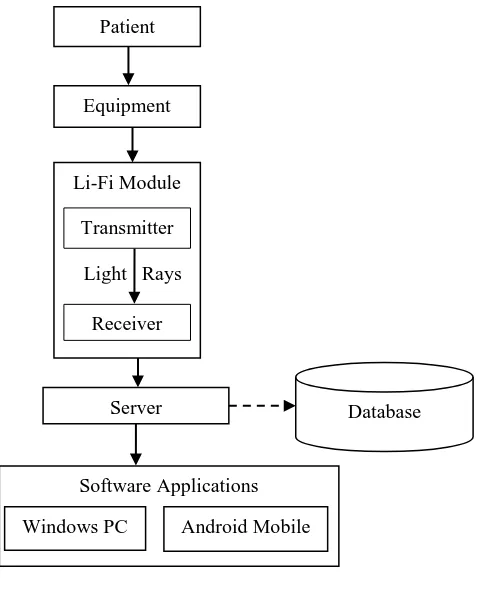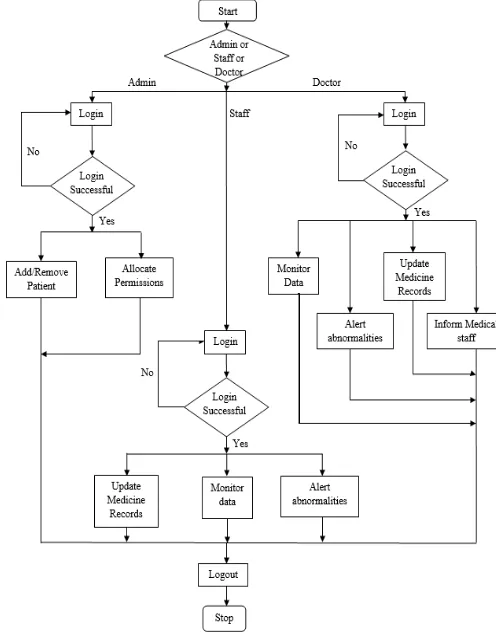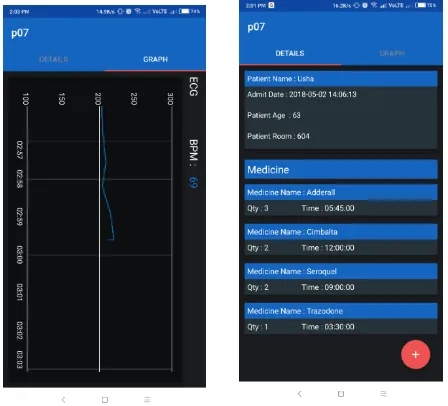International Journal of Emerging Technology and Advanced Engineering
Website: www.ijetae.com (ISSN 2250-2459, ISO 9001:2008 Certified Journal, Volume 8, Issue 7, July 2018)International Conference on Smart Computing Communication & Control (ICSC3 2018), Organized by
St Joseph Engineering College, Mangaluru, Karnataka, India
Page
1
Li-Fi Technology based Patient Monitoring System for
Medical Personnel
Harold Vijeth Amin
1, Merwin Trever Ferrao
2, Anoop Kumar
3, Lasya Hegde
4, Supreetha R
5Department of Computer Science & Engineering, St Joseph Engineering College, Mangaluru
Abstract—Hospitals are adopting wireless technologies and
patient monitoring systems that have the potential to change the way medical personnel and healthcare institutions operate. Popular wireless networking technology, Wi-Fi, is avoided in hospitals due to the interference of radio waves with medical equipment as well as human body. Li-Fi is a Visible Light Communications (VLC) system with wireless communications travelling at very high speed. The proposed system uses Li-Fi technology for data transmission in radio wave sensitive areas and is designed to ease the process of monitoring patients in hospitals. The medical personnel can access the data using the software applications, which in return gets the data from the server that is uploaded from the Li-Fi module. The Li-Fi module consists of transmitter and receiver circuit.
Keywords—Li-Fi, VLC, LM386, Wireless Communication, Arduino.
I. INTRODUCTION
In today’s world, Communication systems is one of the technology that is advancing very quickly. Radio wave technology is the most preferred choice for wireless data transmission. Wi-Fi(Wireless-Fidelity) is a commonly used technology that uses radio waves for wireless local area networking. Although it is widely used in many fields they cause problems in critical care environment, one such field is healthcare. ElectroMagnetic Interference (EMI) with medical equipment in Intensive Care Unit (ICU) causes catastrophic failure in their functionality due to their close proximity to electromagnetic field emitters such as Wi-Fi routers. As a result, many institutions are banning these devices. One of the recent technological development, Li-Fi which is a Visible Light Communications (VLC) [1] system with high speed bi-directional network that transmits data using light can be used in such critical care environments to replace Wi-Fi without compromising the functionality of the devices as
well as the safety of the patients [2]. Also, in Hospitals, the excess paper work is generated while monitoring patients and labour power is wasted in shuffling between doctors.
The prototype of the system describes how hospital personnel can update and organise patient details and monitor real time vitals of the patients using Li-Fi technology.
II. BACKGROUND
The term Li-Fi was coined by the widely recognised original founder of Li-Fi, that is, Professor Harald Haas from the University of Edinburgh in the United Kingdom. He is also the Chairman of Mobile Communications at the University of Edinburgh and co-founder of pure Li-Fi [3].
In October 2011, some companies and industry groups came together and formed the Li-Fi consortium to overcome the disadvantages of radio wave technology and to encourage high-speed optical wireless system. Later in 2013, data rates of the transmission of over 1.6 Gbit/s were demonstrated. The Russian company Stins Coman announced the development of a Li-Fi network called BeamCaster in April 2014.
Although, many researches and projects had been done on this technology, no cheap and efficient module for Li-Fi is available in the market presently. Hence, this technology is still in the process of Research and Development.
III. PROPOSED SYSTEM
International Journal of Emerging Technology and Advanced Engineering
Website: www.ijetae.com (ISSN 2250-2459, ISO 9001:2008 Certified Journal, Volume 8, Issue 7, July 2018)International Conference on Smart Computing Communication & Control (ICSC3 2018), Organized by St Joseph
[image:2.612.57.296.142.437.2]Engineering College, Mangaluru, Karnataka, India
Page
9
Figure 1: System overview
The proposed system simulates an ECG equipment whose data is transmitted through light. The data is received and uploaded to the database on the remote server. The system accesses these values in real time and displays it to the authorized user (doctor or medical staff).
Traditionally, the doctors have to be physically present to monitor patient health status but with our proposed system, hospital staffs can remotely monitor patient status and notify other staffs assigned to the patient in case of abnormalities. Based on the proposed system, a prototype model is built to test the concept of Li-Fi which acts as the physical layer for half-duplex type raw transmission of data in hospital.
The prototype model consists of hardware and software system. The hardware system involves the receiver, transmitter and a simulated ECG equipment. The software system is developed for two platforms Windows and Android. Both the platforms allow the staff to access patient details and monitor data remotely. The
administrator login is only available in Windows application.
The overview of the system is shown in Figure 1.
A. Patient
The equipment, present in the patient’s room, is used to monitor the patient’s vitals.
B. Equipment
The patient’s data from the medical equipment is given to the Analog-to-Digital Converter (used to convert the analog data got from the equipment to digital data). This converted data is given to the transmitter circuit of the Li-Fi module.
C. Li-Fi module
Li-Fi module consists of the transmitter circuit and the receiver circuit.
Transmitter circuit: The transmitter circuit, as shown in Figure 2, consists of a panel of LEDs connected in parallel, 5-volt battery and connected to an Arduino. The digital data is sent from the transmitter circuit using LEDs to the receiver circuit. The raw data value is converted to 16-bit binary representation and transmitted. The protocol for transmission, which involves use of start and stop bits to represent start and end of data, is coded into the program of the Arduino. The synchronisation is achieved by using fixed delays on both receiver and transmitter circuits.
Figure 2: Transmitter circuit
Receiver circuit: The data is received by the receiver circuit using solar panels which is used as a photodetector. The received signal is amplified using LM386 a low Equipment
Patient
Software Applications
Android Mobile Windows PC
Database Server
Li-Fi Module
Transmitter
[image:2.612.345.566.490.645.2]International Journal of Emerging Technology and Advanced Engineering
Website: www.ijetae.com (ISSN 2250-2459, ISO 9001:2008 Certified Journal, Volume 8, Issue 7, July 2018)International Conference on Smart Computing Communication & Control (ICSC3 2018), Organized by St Joseph
Engineering College, Mangaluru, Karnataka, India
Page
10
[image:3.612.76.312.214.372.2]voltage signal amplifier IC. The circuit is as shown in Figure 3. The light rays corresponding to the transmitted signal stimulates the solar panel, which serves as input to the amplifier circuit. The data from the signal is extracted using the code in the Arduino and this data is uploaded to the server.
Figure 3: Receiver circuit
This transmitter-receiver circuit accounts for the real time transmission feature of this project using Li-Fi technology. The uploaded data can be accessed by any authorised personnel using the mobile application or the windows application.
D. Server
The data from the receiver circuit is uploaded to the server. The server used in the proposed system is Apache server hosted on Raspberry Pi.
E. Database
All the details of the patient and staff as well as the real time data obtained from the equipment is stored in the database. The database used is MariaDB 10.
F. Software Applications
The system involves a mobile application which is developed using Android Studio for Android platform and windows application is developed using Visual Studio 2017.
The system’s flow design, based on the use cases, is shown in Figure 4 and both the applications are based on this system flow design.
Android Mobile: The application supports Android version 5 and above. It uses PHP code to access and retrieve the data from the MySQL database hosted on the remote server. Doctor and Medical Staff can access the real time data of the assigned patients using this application.
Screenshots of the Android application for patient details is shown in Figure 5.
Figure 4: System Flow Design
Windows PC: The application supports Windows OS. In addition to Android application’s features, Admin access is provided in this application.
[image:3.612.334.582.219.535.2]International Journal of Emerging Technology and Advanced Engineering
Website: www.ijetae.com (ISSN 2250-2459, ISO 9001:2008 Certified Journal, Volume 8, Issue 7, July 2018)International Conference on Smart Computing Communication & Control (ICSC3 2018), Organized by St Joseph
Engineering College, Mangaluru, Karnataka, India
Page
11
[image:4.612.66.290.265.468.2]Both applications provide an easy UI and allows authorised personnel such as doctors and medical staff to access patient’s details in real time from the data uploaded by the hardware components. In addition, the software also provides various features to reduce paper work involved in handling patients by keeping track of medicines to be given, patient records, equipment allocated to patients, alert system, notification system etc.
Figure 5: Android application screenshots
Figure 6: Windows application screenshot
IV. RESULTS
The proposed system shows the patient details as well as equipment values from the equipment through the Li-Fi network. The real time values are shown in the software application in the graph as well as text format (whichever is applicable).
The maximum IO speeds of Arduino are the bottleneck for the speeds achieved. Hence, the speed observed in the transmission of data through the Li-Fi network is around 200Bits/s which was sufficient for the smooth transfer of data in the proposed system. The proposed system works efficiently when the distance between the transmitter and the receiver is approximately 10-15 feet.
V. CONCLUSION
Experts often compare Li-Fi to free space optics as it also utilizes light to transfer data but it cannot be used in the places where it is difficult to lay the optical fibre like hospitals. Li-Fi-based health-care monitoring hospital system secure patient’s body from attack of many types of disease by notifying the abnormality to the medical personnel. Not only improving the patient’s health conditions but also communications among the physicians(doctors) and clinicians (medical staff). Since the technology involves visible light wavelength and not radio waves, it is less likely to have a negative effect on human health. Moreover, with the advancement in the field of bio-tech and the advent of robotics in the field of medicine, Li-Fi holds a promising future for the networked use of various equipment [2].
Drawback of Li-Fi is that it can only transmit when the light rays are does not pass through any obstacle and has a clear line of sight to the receiver [3].
[image:4.612.59.310.500.669.2]International Journal of Emerging Technology and Advanced Engineering
Website: www.ijetae.com (ISSN 2250-2459, ISO 9001:2008 Certified Journal, Volume 8, Issue 7, July 2018)International Conference on Smart Computing Communication & Control (ICSC3 2018), Organized by St Joseph
Engineering College, Mangaluru, Karnataka, India
Page
12
A detailed study has been conducted to find the various requirement of the system and it has been designed in an attractive manner, so even a user who has basic knowledge about the computer can be able to operate the system easily.
VI. FUTURE WORK
Future scope for this system lies in decreasing product size and transferring data at higher speeds and mainly by encrypting the transmission of data. The size of the Li-Fi modules can be decreased in future and also an attempt to increase the transfer speeds of data can done in the future. The system can be made secure by using an encryption technique for the data transmission using Li-Fi.
References
[1] Harald Haas. 2015. Visible light communication, Optical Fiber Communications Conference and Exhibition (OFC), 2015.
[2] S. Sudha, D Indumathy, A Lavanya, M Nishanthi, D Merline Sheeba, V Anand. 2016. Patient Monitoring in the hospital management using Li-Fi. Technological
Innovations in ICT for Agriculture and Rural Development (TIAR), 2016 IEEE.
[3] Harald Haas, Liang Yin, Yunlu Wang, and Cheng Chen. 2016. What is LiFi?. Journal Of Lightwave Technology, Vol. 34, No. 6, March 15, 2016.
[4] Porselvi S, Bhagyalakshmi L, Sanjay Kumar Suman. 2017. Healthcare Monitoring Systems Using Li-Fi Networks. Innovare Journal of Engineering & Technology - Vol 5 Issue 2 2017 (March-April).


